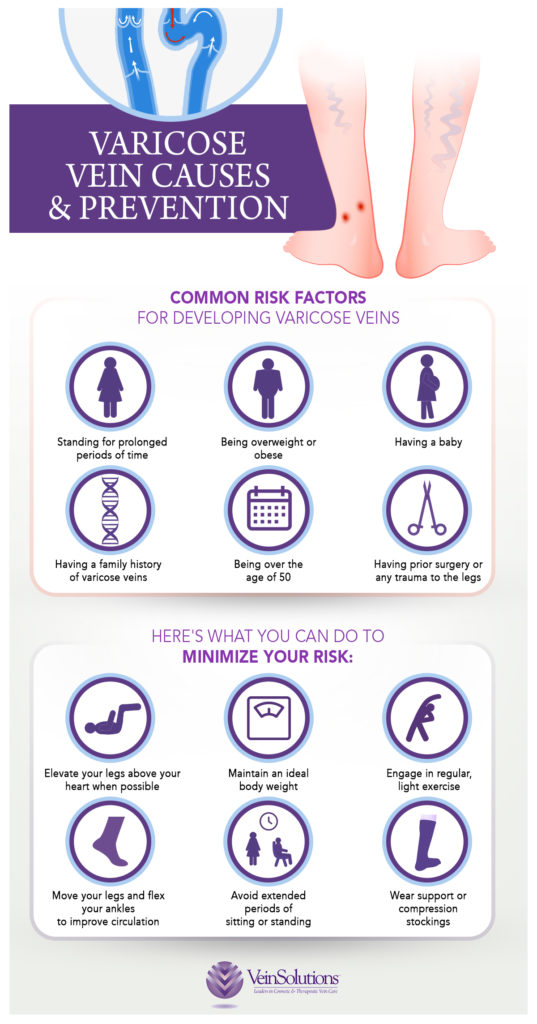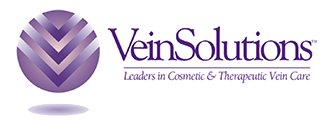More than 35% of people in the United States suffer from varicose veins, and of that group, it is women who are typically affected the most by this condition, according to the Society for Vascular Surgery.
What are Varicose Veins?
Varicose veins appear as thick, ropey, knotted structures under the skin which can become swollen and painful. While they can pop up anywhere on the body, they most often develop on the legs and thighs.
Possessing an abnormal structure that causes them to function improperly when transporting blood, varicose veins can lead to blood pooling and a swollen, bulging appearance.
Many of our patients at VeinSolutions ask, ‘are varicose veins dangerous’?
The answer is typically no and that they do not indicate any serious medical issues. Though they can be unattractive and uncomfortable, and because they contribute to inefficient blood circulation, there are several forms of vein treatments available to minimize or remove varicose veins altogether.
What causes Varicose Veins?
Normal veins operate with tiny valves that help pump blood through the body back up towards the heart. In someone with poorly functioning veins and valves, the blood flow can actually be reversed and flow downward through the lower body to the legs.
This increased pressure put on the superficial veins by the backflow of blood builds up over time and causes varicosities, or varicose veins.
Several risk factors that put pressure on the body and may potentially lead to the development of varicose veins include:
- Frequent, prolonged standing
- Obesity
- Family history of varicose veins or other vein disorders
- Prior surgery or any trauma to the leg
- Age
- Pregnancy – due to the increased blood volume associated with pregnancy, varicosities can occur. Additionally, added pressure on the veins in the legs from the weight of the growing uterus and the relaxation effects of estrogen and progesterone on the vein walls contribute to the development of varicose veins.

What are symptoms of Varicose Veins?
Varicose veins usually develop gradually over time with their bulging, knotty appearance being one of the first indications that you have them. They are also often dark blue, purple, or red in hue showing up brightly under the skin and may be hard or sensitive to the touch.
In addition to the cosmetic concern that varicose veins present, approximately 50% of those with the condition also experience:
- Feelings of leg fatigue, aches, burning and pains, especially after prolonged standing
- Night cramps
- Leg and ankle swelling
- Increase in symptoms during the menstrual cycle
Tips to help alleviate symptoms and prevent varicose veins from forming include:
- Elevate your legs when possible keeping your feet positioned higher than your heart.
- Maintain an ideal body weight.
- Engage in regular exercises with simple activities like walking, stair climbing, swimming and cycling to activate your calf muscles.
- Move your legs as frequently as possible to imitate the walking motion and flex your ankles to pump blood and improve circulation.
- Avoid extended periods of sitting or standing.
- Wear support or compression stockings to prevent swelling and blood from pooling downward in the legs.
How are Varicose Veins treated?
There are several treatment options that VeinSolutions offers for varicose vein removal.
These treatments are intended to both help ease the symptoms of varicose veins as well as improve the look and feel aesthetically of the affected areas.
Sclerotherapy is an injection treatment used to remove spider veins and small- to medium-sized varicose veins. These abnormal veins are injected with a solution that is irritating to the vein wall causing it to break down and eventually become absorbed by the body and then eliminated. Sclerotherapy is performed simply in-office by our board-certified physicians and allows you to return to normal activities (excluding heavy lifting and exercise) in about three days after the procedure. In some cases, multiple treatments may be necessary to break down the varicose veins.
Endovenous ablation is another non-surgical, minimally-invasive treatment option for varicose veins. It is also performed in-office with little to-no downtime after the procedure. The ablation is done by inserting a small catheter into the problem vein followed by a thin fiber that emits radio-frequency energy, or heat, to the vein wall. The targeted heat shrinks the vein wall and seals it closed rerouting the blood upwards to other healthy veins. Endovenous ablation has excellent long-term results and typically requires only one treatment.
Minimally invasive varicose vein surgery is often the best choice for larger veins when other treatments have proven unsuccessful. The goal in varicose vein removal surgery is to achieve the best cosmetic results with minimal scarring and to relieve symptoms of pain or swelling that often occur. Today, with the combination of the technology of venous duplex imaging and the meticulous surgical techniques of our highly-trained vascular surgeons, patients are able to attain both optimal cosmetic and therapeutic results. Surgery is typically performed in our office procedure room on an outpatient basis with an average recovery time of one to two weeks.
At VeinSolutions in Austin, Georgetown, and Kyle, we want to help you regain the look and feel of the legs you love!
Varicose Veins FAQ
Is there any way I can prevent varicose veins?
There is no known way to stop varicose veins from forming. However, there are things you can do to minimize the symptoms once you notice varicose veins, including maintaining a healthy weight, wearing compression stockings, and avoiding sitting or standing for extended periods of time. It’s important to seek medical treatment as early as possible to minimize symptoms.
Can I improve varicose veins with diet and exercise?
Your diet can definitely play a role in the severity of varicose veins. In short, you need a healthy body to have healthy veins. Salty foods can cause water retention, and dairy and red meat can cause constipation, both of which put greater pressure on the veins. Eating fruits, vegetables and high-fiber foods can help to improve your vein health.
Regarding exercise, low-impact exercises such as swimming, walking or light aerobics are best to maintain healthy veins. Running, lifting heavy weights, aggressive cycling and other more strenuous activities will put added pressure on your veins.
I have spider veins. Will they become varicose veins if untreated?
Spider veins are darker veins that generally do not protrude from the skin. They are caused by milder swelling in the veins and are usually much less uncomfortable compared to varicose veins. For the most part, spider veins and varicose veins are two separate medical conditions. That doesn’t mean that a person can’t have both, but the presence of spider veins does not mean that a person is more likely to develop varicose veins.
What about the use of compressions stockings?
Using compression stockings is often an excellent first step to treat varicose veins. These stockings work by applying pressure to the veins, which stimulates blood flow and reduces inflammation. In many cases, the use of compression stockings alone will not adequately treat varicose veins, but they can be an excellent add-on therapy for the treatment options we offer at VeinSolutions. We’re happy to advise on which type of stocking may be best for you and alternatives if compression stockings are not helping to minimize your varicose vein symptoms.
What happens if I don’t treat my varicose veins?
Varicose veins usually become worse over time. Pain may increase and you may experience additional complications such as skin sores or ulcers, blood clots, or even deep vein thrombosis (DVT). Prompt treatment of varicose veins can minimize the risk of these potentially serious complications.
How are varicose veins diagnosed?
We use an ultrasound exam during your initial appointment to see inside the leg and determine the degree of venous reflux present. Pairing these results with a physical exam and review of your health history gives our vein doctors a complete picture of your vein health.
Won’t treating varicose veins reduce blood flow?
Actually, the opposite occurs. Varicose veins lack a healthy blood flow, so closing them off improves blood flow because blood is routed through other, healthier veins.
What can I expect when I visit your office?
On your first visit, you’ll complete a patient health history form and meet with one of our vein specialists for a physical exam. As part of the exam, we take photographs of the areas where varicose veins are present so that we can track treatment progress over time. In addition, an ultrasound device is used to help your doctor assess the condition of your veins and plan a course of treatment.
Will I need to be hospitalized or take time off work?
All of the treatments we perform at VeinSolutions are performed on an outpatient basis, meaning a hospital visit and stay are not required. Treatments are minimally invasive and a local anesthetic will minimize any discomfort. Some patients are ready to return to work or their day’s other activities right after treatment, while for more extensive procedures, you will be advised to take a day or two to rest and recover.
What happens to my vein after it has been treated?
This depends on the type of treatment. Sclerotherapy causes the treated veins to collapse, and they are then gradually reabsorbed by your body. Endovenous ablation closes the treated vein with radiofrequency energy, and it is again absorbed naturally by your body. During minimally invasive vein surgery, affected veins are physically removed.
